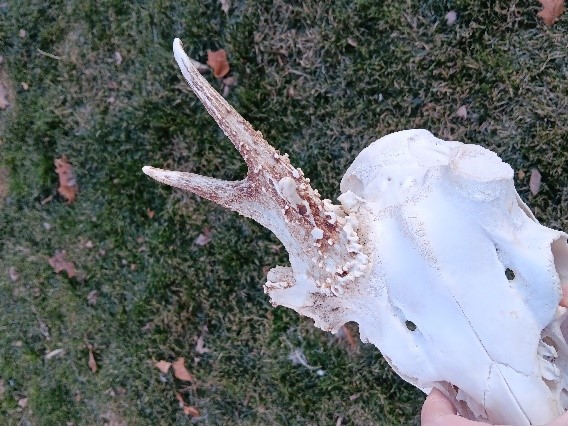
By Brian Peterson & Greg Wagner
If you observed or harvested a deer, it is usually obvious that the buck’s antlers belong together based on their similar size, configuration and how they are situated upon the skull.
Did you know?
Deer antlers are perennial, rapid growing, and costly to produce appendage, and in white-tailed deer they are genetically coded to have perfect symmetry between sides. Major to minor asymmetries however do occur in all individuals due to leg and skull injuries, injury in velvet, environmental stressors, breakage, parasites, disease, etc.
So, what if you find a couple shed antlers while out hiking in the woods. How do you know you if you found a match set or antler pair from the same deer?
Well, you would know if you had a history with that buck, maybe you saw him personally with those unique antlers, you had trail camera photos of him, or you saw him shed both antler sides.
But if you do not have a history, how do you really know? Maybe they were lying 25 feet apart, 5 feet apart, or on top of each other. The distance apart may provide some confidence they may be the same deer, but not always.
We recently completed a research project at the University of Nebraska-Kearney (UNK) where we found that on average, antler sides were more than 125 yards apart, while less than half collected within 10 yards of each other.
Without any history with the deer or distance apart information, how do you really know? What if a friend brought you an antler pair with 4 points on each side? How could you systematically determine they were from the same deer without any additional information? Hmmm…
Well, you could genetically get them tested. Zach Carter, a graduate of UNK, investigated this and he was able to confirm from the skin ring (see below photo) on two sheds that they were indeed the same individual, and even the same individual in subsequent years. This was great, but his methods required specialized training and expensive equipment, of which most of us do not have!
So, with few details regarding when and where the sheds were acquired, let us go through the process to know if they are likely a match set. We will start basic and then get more complex.
First, we need to make sure that both sides are from white-tailed deer. Second, we need to make sure we have 1-right and 1-left side. And third, we need to check the base of the shed antler for the presence of a waxy skin ring (see above photo), indicating the antlers were recently shed this season (fresh/fresh). If not, they should both be old, indicating they have both been in nature 1 or more years.
Next, we can examine common antler characteristics to figure out if it is worth investigating further. Visually look at the pedicle seal depth and shape/area. If they are similar between sides, you may have a match set. Look at the brow tines and antler points. Roll both antlers back-to-back to see if the matching antler tines branch at similar points along the main beam. Finally, the brow tines/eye guards and antler tines should branch at similar angles when compared between sides. You can stop right here and make your educated guess, or you can dig deeper with antler metrics to deduce a match set more confidently.
Keep in mind all deer are unique so this is not a guarantee. Like in all wild animals there are exceptions and outliers.
Over the past 14 years at UNK we have collected and obtained measurements on nearly 200 shed antler pairs. We investigated 14 antler measurements between sides to determine the best metrics to define a match set. These measurements included: Main beam length, main beam circumference, antler points, antler tine lengths, total antler score, antler weight, pedicle seal depth and shape.
We observed that the most symmetric measurements between sides were the best to confirm an antler pair. The best measurements were main beam length and first three main beam circumferences. This is probably due to these measurements being the first initiated or oldest antler growth. Furthermore, we found that older deer had more symmetrical antlers, likely due to their ability to buffer out environmental stressors that may redirect normal antler growth causing abnormal characteristics between sides.
The weakest or worst symmetric measurements or characteristics to confirm an antler pair included total antler point lengths and total points. This is due to the variation in points between sides and comparison of broken points.
Currently, Bryce Sutton, a UNK undergraduate, is researching nontraditional antler metrics to confidently define an antler pair. He is investigating measurements including antler point branching angles, point branching distance and non-broken matching points. Stay tuned for his results in the near future!
Acknowledgements: We thank UNK Graduate Anna-Maria Easley for the antler figures, landowners who have allowed us to search their properties for shed antlers, as well as the citizen scientists that have allowed us to measure their antlers over the years.
